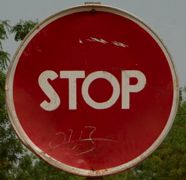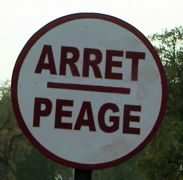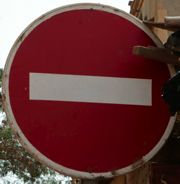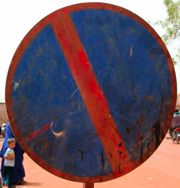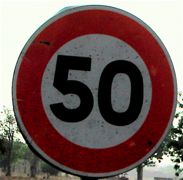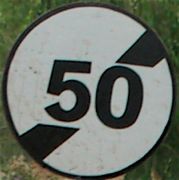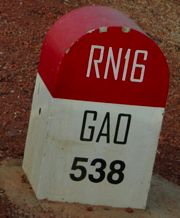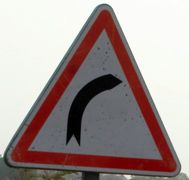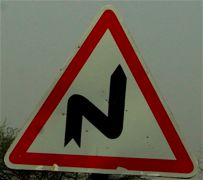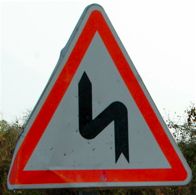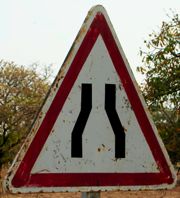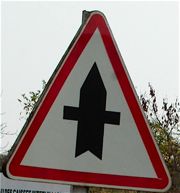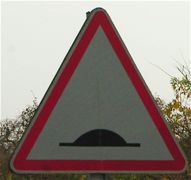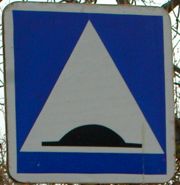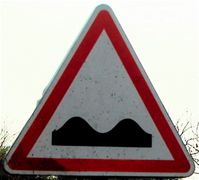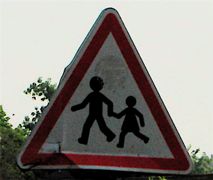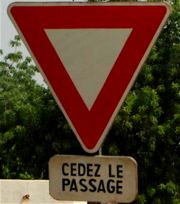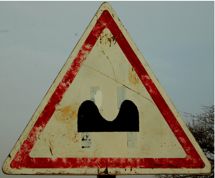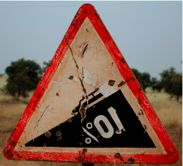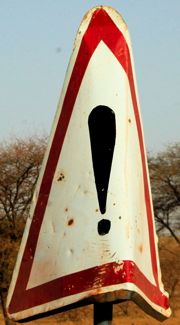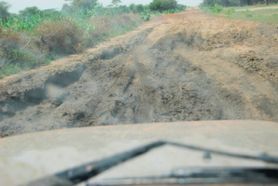
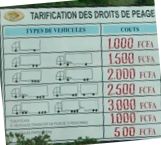
Road Signs: There are three main types of road signs your will encounter. Speed limit signs are round with the maximum speed in black in the centre. Warning signs are not orange diamonds as is typical in North America but rather white triangles with a red boarder and an image of the danger in the centre. Common warnings are sharp curves, animal crossings and speed bumps ahead. The other common signs are those indicating entering or exiting a town. Upon entering a town, or passing a village that is visible from the road, you will see a white rectangle with the name in black. When you leave the “city limits” the same sign will have a red slash across it. See the side bar for an example of the signs in use in Mali
Signals: Technically in Mali turn signals are to be used as elsewhere to signal passing, switching lanes, and turning off the road. However, while Malian drivers may or may not use their turn signals for these purposes they almost all used the blinkers to indicate if it is safe to pass. Drivers that see another vehicles approaching in the opposite direction will turn on the left turn signal to indicate to any drivers behind them that there is a car in the opposite lane. It may also work as a signal to the oncoming driver hey stay in your own lane we are coming. When the road is clear and the lead car is slow moving or other it will signal with the right turn signal so any following cars will know the way is clear ahead if they wish to pass. Sometimes in this case they will even stick their arm out the window and wave the cars by. In some cases when going around a very tight curve a driver might turn on his signal in the direction of the curve to warn any cars behind to be careful, this is most common at night.
It is common for Malian drivers to honk as a salutation. They do this either when they recognize the vehicles and the thus know the driver/owner, or as a sign of solidarity between members of a driving fraternity. For example the drivers two big trucks or a pair of buses especially of the same bus company passing one another will honk.
Even in the day drivers may flash their headlights at you. This is not because you have your high beams on but as a signal to say “Hey, see me driving down the road please stay/ get back on your own side of the road until we pass each other.”
Animal Crossing: Mali is a land of herders without much in the way of fencing. Many families will have at least a goat or two that they will let out during the day to graze where they will. In rural areas large herds of goats sheep and cows are led out in search of pasture and water. Numerous donkeys wander the area. Beasts of burden such as horses, donkeys or camels may be led along the same track that is used by motor vehicles. Around villages and in the bush one must be prepared to react to animals in the road. It may be a herd of hundreds being driven across to water or pasture it might be a few foolish beasts just standing there. Reduce your speed and lean on your horn but be prepared to come to a complete stop as the animals do not always move or may move in the wrong direction.
Other Drivers The roads are used by numerous public transporters who may stop to pick up or drop off passengers at unlikely places. Be conscious of what other vehicles are doing and keep a safe following distance in case of abrupt stops.
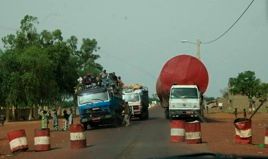
There are frequent curves in the roads these are mostly marked with warning signs. Few of them are so tight as to require a driver to slow significantly to take them. However, with blind curves and rises, it is best to hug your side of the road and refrain from passing until you can see clear again. Oncoming traffic may be large and speeding down the centre of the road or overtaking a slow cart regardless of visibility. You want to be prepared not to meet it head on.
Rough Roads On tracks such as the road between Douenza and Timbuktu these combinations of overloaded trucks, rains, and sandy or clay ground leads to uneven roads. In places the track maybe a pit of soft sand in others hard washboard, still others places may turn to a mud hole during the rains and be gouged out by the big trucks into great ruts which harden that way. Seasonal streams run across the road eroding places where concrete reinforcement meets the natural road bed. Care should be taken when driving on such roads. Drive at reasonable speeds and reduce your speed when you can not see around a curve or over a slight rise; you never know when a great pot hole is waiting to break your springs and shocks.
The paved roads have posted speed limits that are frequently reduced to protect the residents of the small settlements along the roads. However drivers rarely respect the posted limits. To enforce them speed bumps are places at both sides of every village and at regular intervals through the town itself. The local people call them “gendarmes couchés” which means sleeping policemen. Some of these are big enough to be entire brigades napping in the road in a big puppy pile. What’s more they may have a big pot hole right at the summit. You will want to slow to a crawl when crossing these. In most cases the bumps are signalled with a warning triangle and often they are preceded by a series of smaller bumps that alert you to the upcoming giant but in a few cases they aren’t. It is highly recommended that you use extreem vigilance when entering towns or villages.
Breakdown Etiquette It is not uncommon for vehicles to break down especially on rough tracks like that between Timbuktu and Douenza. It is true that part of the reason is that the vehicles are often old and in precarious condition to begin with but the road conditions are rough enough that even new vehicles can be damaged. The washboard ruts are very jarring in which case if is recommended to go at a higher speed to skim over the tops of them or take advantage of the deviations in the softer sand which at least gives a smoother ride. But beware of the big pot holes and ruts that hitting at high speed can cause not only serious damage to a vehicle put personal injury as well. That said you will likely encounter vehicles broken down beside the road. In some cases the driver, his apprentice or other passengers will be calmly whiling away the time in the shade while they wait for repairs to be made or someone to come back with a part. However if someone waves you down it is good policy to stop and see what he needs. It may be that he has been waiting for a long time (sometimes days) with the vehicle while another had gone for parts and he has run out of water. In a case like this if you have some water to spare please give some. It maybe that the person needs a ride to the nearest town to get parts or help. If you have space it is good policy to give a ride. It may be a simple request to call someone for aid once you get in range of cell phone signal. If you have a cell phone it is a good policy to accept the commission and once accepted please se sure to fulfil it with due speed. Remember you could be broken down somewhere and need such assistance yourself sometime.
It is also recommended to bring along a large (20L/5Gal) jug of water. Tap water is fine. It will serve for washing up, washing the windshield, replenishing the radiator, and drinking. Even if you bring along bottled water this is a good back up in case you need it. If you are worried about water quality have some purifying tablets, drops or other system along to make it drinkable. See the health section for information on making water potable.
Dangers of driving at night: Added to all of the above dangers many vehicles in Mali do not have working head lights. This does not stop them from useing the roads even at night, nor bicycles nor donkey and horse carts. With the limited visibility of night driving in general we have elevated risk of hitting animals in the road, or potholes and speed bumps, having collisions with other vehicles which we can’t see, or with exhausted drivers who have been on the road since dawn. If you must drive at night be sure that you are well rested and alert, be vigilant and do not use excessive speeds.
City Driving Driving in towns has its own challenges:
- The streets are often narrow
- They are often pitted and puddled with wastewater
- The may be piled with construction materials such as heaps of clay or drying bricks
- They maybe blocked by parked cars, trucks or motorbikes
- Two cars may stop abreast for the drivers to chat
- Cars and Motorbikes will drive some distance on the wrong side of the road if it is easier they turning left across traffic twice to get to their next destination not far down the street.
- Vehicles often do not signal intended turns
- They often do not respect yield signs, yielding when they don’t have to, and cutting you off when you should have the right away.
- They often don’t respect stop signs or the order of going at a four way stop.
- In places that have traffic signals the often don’t work and are often set so far back that the first cars at the intersection can not see them.
- Motor bikes squeeze in any space they can get.
- Pedestrians often do not pay attention to motor vehicle traffic.
- In finding a space in or across traffic it is often the law of the most aggressive. Be prepared to be cut off and to force your way by nosing into any space available until oncoming traffic is forced to let you through.
- In big cities, like Bamako, Police officers often direct traffic at tough intersections. Respect them.
Timbuktu: Has recently had a few of its roads paved. These roads have now been fitted with speed bumps to enforce low speeds. There are none on the Route de Kabara the main paved road coming into town form the ports and airport to the Place d’Indépendance round point. As the asphalt turns left past the military camp there is one bump. When it goes around the corner there is another bump even with the end of the grand mosque. Then another even with the high school. Three close together follow it. One on the south side of cobbled road up to the Grand Marché. One on the north side of that road and one on the north side of the street to the right and the Petit Marché. You will then curve around another round point, if you chose to take the pavement north of the small round point you will find one in the middle of the paved section halfway between the round point and the stop sign and two on the paved street west of the stop sign towards the flamme de la paix. If you go right at the round point instead there is one between that round point and the Monument des Martyrs. At the Monument des Martyrs turn right past the centre de santé and then left again past the other end of it on to the other main paved road. This thoroughfare is commonly known as Faru Ber. There is a speed bump at the top of the incline on that street and then three more spaced along it. Turn right again at the round point at the other end of this street and there are two along that section before you come out onto the Route de Kabara just south of the post office and not far from the Place d’Indépendance.
ONE WAY STREETS: There are a few one way streets around the grand market. The main cobbled street coming from the Place d’Indépendance is one way to the north towards the market. The main cobbled street heading between the grand marché and the petit marché is one way, east to west heading away from the grand market. The narrow track heading from the north end of Takaboundou west to the gare routière is one way east to west. The narrow track heading from the grand marché north, northeast to Takaboundou is one way south to north. All other streets have no indicated direction but be careful In the old town some are too narrow to be navigated in a car. and some are too messy with soak pits and such to be easily navigated even in the straight blocks of the newer neighbourhoods. The farther out of town you go in any direction the sandier the streets become the less packed with traffic and clay runoff from houses etc.
